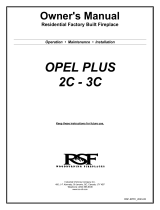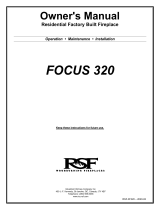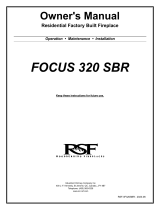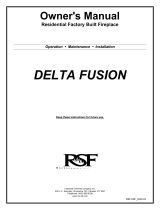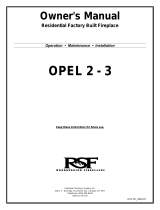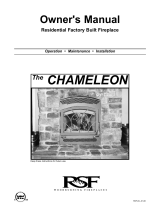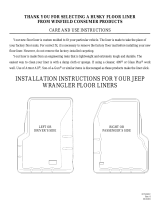Page is loading ...

RSF-IIR2_2009-03
Owner's Manual
Residential Factory Built Fireplace
Operation • Maintenance • Installation
ORACLE2
Keep these instructions for future use.

ORACLE2 Owner's Manual 2 RSF Woodburning Fireplaces
Dear Customer,
The ORACLE2 incorporates technology with elegance to give you a beautiful view of the fire
without compromising on heating efficiency or environmental quality.
We have designed your new ORACLE2 to be easy to install, operate and maintain. It is in your
best interest to become familiar with it. Study your manual to be sure that the installation is
correct, then follow the guidelines for operation and maintenance.
We at RSF Woodburning Fireplaces congratulate you on your choice of the ORACLE2, and
are confident that you have purchased a fireplace that is simply, the best.
Sincerely,
RSF Woodburning Fireplaces Team
March 2009
TABLE OF CONTENTS
SAFETY FIRST 3
DO'S AND DONT'S 3
CREOSOTE: FORMATION AND REMOVAL 3
GENERAL SPECIFICATIONS 4
CONTROLLING THE HEAT OUTPUT 4
OPTIONS 4
UNIT DIMENSIONS AND CLEARANCES 5
OPERATION 6
CONTROLLING THE FIRE 6
LIGHTING 6
THE FIRST FIRES 6
REFUELING 6
MAINTENANCE 6
GENERAL CLEANING 6
PAINT 6
GLASS CLEANING 7
CHIMNEY CLEANING 7
DISPOSAL OF ASHES 7
DOOR ADJUSTMENT 7
GOLD PLATING 8
INSTALLATION 8
STANDOFFS INSTALLATION 8
LOCATION 8
CEILING CLEARANCE 9
OUTSIDE AIR DUCT 11
CHIMNEY 11
CHIMNEY INSTALLATION 12
OFFSET CHIMNEY 12
CHASE ENCLOSURE 13
MASONRY CHIMNEY 14
FRAMING 16
HEARTH EXTENSION 16
BENEATH HEARTH EXTENSION 16
MANTEL 16
REFRACTORY BRICK INSTALLATION 17
GAS LOG INSTALLATION 17
LISTING LABEL 19
COMPLETE OPTIONS LIST 20
REPLACEMENT PARTS 21
LIMITED WARRANTY 23

ORACLE2 Owner's Manual 3 RSF Woodburning Fireplaces
SAFETY FIRST
DO'S AND DONT'S
If this fireplace is not properly installed, a house fire could result. For your safety and that of your family,
follow the installation directions. Contact your local authority having jurisdiction (such as municipal
building department, fire department, fire prevention bureau, etc.) regarding restrictions and installation
requirements, and the need to obtain a permit.
To ANYONE using this fireplace: these DO's and DON'Ts are for your safety.
1. DO read this instruction manual before lighting your first fire.
2. DO burn seasoned wood fuel or densified fuel logs without any additives.
3. To avoid glass breakage, DO NOT slam the fireplace doors.
4. DO NOT ever use gasoline, gasoline-type lantern fuel, kerosene, charcoal lighter fluid or similar liquids to
start or freshen up a fire in this fireplace. Keep all such liquids well away from the fireplace while it is in use.
5. DO NOT overfire the fireplace. If the chimney connector behind the top louver glows red, you are
overfiring the fireplace.
6. DO operate the fireplace with doors fully closed. If a door is left partly open, gas and flame can be drawn
out of the fireplace opening, creating both fire and smoke hazards.
7. DO keep all combustible materials (furniture, firewood, etc.) at least 4' away from the front of the fireplace.
8. DO NOT use a fireplace grate or other products not specified for use with this fireplace.
NOTE: We strongly recommend that our products be installed and
serviced by professionals who are certified by the National Fireplace
Institute in the U.S. or by Wood Energy Technology Transfer Inc. in
Canada.
CREOSOTE: FORMATION AND REMOVAL
When wood is burned slowly, it produces tar and other organic vapors which combine with the expelled moisture
from the wood to form creosote. The creosote vapors can condense in the relatively cool chimney of a slow
burning fire. When ignited, this creosote makes an extremely hot fire. The chimney should be inspected
periodically during the heating season to see if a creosote build-up has occurred. If a significant layer of creosote
has accumulated (¼" or more), it should be removed to reduce the risk of chimney fire.
WARNING: BURN DRY WOOD ONLY. DO NOT BURN: DRIFTWOOD,
TREATED WOOD,
COAL,
GARBAGE, OR
PLASTIC.
Do not use construction scraps (e.g. 2x4 or plywood scraps) as your only supply of fuel as you can overheat and
seriously damage the fireplace. Do not use more than one wax fuel log (e.g. Duraflame) at a time. Use only
firelogs that have been evaluated for fireplace use. In Canada, they should meet the requirements of ULC/ORD-
C127-M1990. Refer to the firelog warnings and caution markings prior to use.

ORACLE2 Owner's Manual 4 RSF Woodburning Fireplaces
GENERAL SPECIFICATIONS
CONTROLLING THE HEAT OUTPUT
The ORACLE2 fireplace is not only designed to provide warm radiant heat on two sides, but also to help heat
your home. Although it does not come with a draft control, you will find that you can control the intensity of the fire
quite well by varying the size and placement of the logs.
For a cooler and lazy fire, load 2 to 3 large logs with the log sides facing you (not the ends) in the center of the
hearth, between the andirons.
For a warmer and brighter fire, load a number of small logs with the ends facing you so that one end comes very
close to the glass. Alternate the logs between both sides of the fireplace, half of the logs close to one glass while
the other half of the logs are closer to the other glass. Since the combustion air is near the glass, it will create a
more vigorous fire.
OPTIONS
Your ORACLE2 fireplace comes equipped with black cast iron doors and black louvers. You can add some color
and style by adding decorative trims to your cast iron doors: gold plated (FO-NDTG) or pewter plated (FO-NDTP).
To simplify the installation of thin non-combustible materials such as ceramic tile or sliced brick, we have
designed a rock retainer kit (FO-KR) It is not designed or required for full brick or stone. Thin materials can also
be installed directly on the face of the ORACLE2 using high temperature silicone as glue, without a rock retainer
kit.
If you have any rooms directly above or adjacent to the room with the fireplace that you would like to heat, you
may want to consider the Gravity Vent Kit (FO-V2). The gravity vent distributes hot air to these rooms and
requires no blower to assist its operation. You could also consider installing a Damper (FO-D) on your gravity
vent. The dampers will enable you to choose between sending the heated air to the gravity vent outlet or keeping
it in the fireplace room.
Detailed installation instructions are included in the box with each option. These can also be obtained from our
Internet Web Site: www.icc-rsf.com.
WARNING: THIS FIREPLACE HAS NOT BEEN TESTED WITH AN UNVENTED GAS LOG SET. TO
REDUCE RISK OF FIRE OR INJURY, DO NOT INSTALL AN UNVENTED GAS LOG SET INTO THIS
FIREPLACE.

ORACLE2 Owner's Manual 5 RSF Woodburning Fireplaces
UNIT DIMENSIONS AND CLEARANCES
23"
11 1/2"
11 1/4"
35 1/4"
38 1/4"
1 1/2"
6 1/2"
18 1/2" 6 1/2"
7"
4 1/4"
29 3/4"
17 3/4"
40"
Refer to Table 1 (G)
for minimum depth
of hearth extension
Refer to Table 1
(B) for minimum
distance of side
wall to the
firebox
opening
Refer to Table 1 (H)
for minimum width
of hearth extension
Non-combustible hearth extension
and spark guard (refer to Table1
(I) and text for particulars)
Refer to
Table 1 (J)
for maximum
mantel shelf
depth
Refer to Table 1 (K)
for minimum mantel
shelf height above
the firebox opening
Figure 1 Dimensions and Clearances
Table 1 Dimensions and Clearances
A Distance of combustible material from side, back and top standoffs 0" (0,0 mm)
B Minimum distance of side wall to the side of the firebox opening, this does not
allow to fully open the door. To be able to fully open the door without any
interference from the side wall, it has to be pushed back at least an additional 10". 9" (229 mm)
C Ceiling clearance: from the base of the fireplace to the ceiling Sealed enclosure
Vented enclosure 7'
6' (2,13 m)
(1,83 m)
D Minimum chimney height: minimum total chimney height from fireplace top to
below the chimney rain cap (at sea level and no offset) 12' (3,66 m)
E Maximum chimney height: maximum total chimney height from fireplace top to
below the chimney rain cap 40' (12,19 m)
F Maximum chimney height supported by the ORACLE2 fireplace 16' (4,88 m)
G Minimum depth of non-combustible hearth extension: from the front of the
fireplace 16" (406 mm)
H Minimum width of non-combustible hearth extension: total width, must be
centered on the firebox opening 40" (1,02 m)
I Minimum width of the spark guard 36" (914 mm)
J Maximum mantel shelf depth 12" (305 mm)
K Minimum height of a combustible mantel shelf above the top of the firebox
opening: from the firebox opening to below the combustible mantel (refer to the
"Installation: Mantel" section for particulars) 24" (610 mm)

ORACLE2 Owner's Manual 6 RSF Woodburning Fireplaces
OPERATION
CONTROLLING THE FIRE
For a cooler and lazy fire, load 2 to 3 large logs with the log sides facing you (not the ends) in the center of the
hearth, between the andirons.
For a warmer and brighter fire, load a number of small logs with the ends facing you so that one end comes very
close to the glass. Alternate the logs between both sides of the fireplace, half of the logs close to one glass while
the other half of the logs are closer to the other glass. Since the combustion air is near the glass, it will create a
more vigorous fire.
LIGHTING
Light a fire in the fireplace, starting with paper and kindling only. Then add three or four pieces of wood, about 3"
diameter. After the fire is established, close the door. Never use any flammable liquids. Once a coal bed is
established, add standard cord wood.
WARNING: DO NOT USE A GRATE OR ELEVATE THE FIRE.
THE FIRST FIRES
You will experience a slow start-up during the first few fires. The refractory bricks contain moisture from
manufacturing and require a few hot fires to evaporate the moisture. While there is still moisture in the bricks, the
bricks will be black with smoke deposits. When the moisture has dissipated, the bricks will turn white. You will
experience a slight odor during the first few fires. This odor comes from curing paint and oil burning off the metal.
Before the first fire, be absolutely sure to wipe off all fingerprints and debris from the gold plating, if you
have chosen any gold plated option. The plating cures during this first fire, and the acid from your finger
prints will permanently etch the gold plating.
REFUELING
Fuel wood can be of any species but the fireplace will not burn cleanly or efficiently unless the wood is well
seasoned. Keep your firewood under cover.
Any door should be opened slowly to keep smoke from spilling into your room. If you have a problem
with smoke spillage, check to see that all kitchen and bathroom fans have been shut off. They can cause
negative pressure in the house which pulls smoke out of the fireplace.
MAINTENANCE
GENERAL CLEANING
The high heat paint and plating can be cleaned with a soft damp cloth. Use a mild detergent and water. Do not
use abrasive cleaners.
PAINT
You can touch up the face of the ORACLE2 with Stove Bright Metallic Black high temperature paint which is
available at most fireplaces dealers. Follow the directions outlined on the spray can. DO NOT attempt to paint the
fireplace while it is still warm. Keep the spray can away from any source of heat or open flame. Ensure that there
is adequate ventilation in the room from the time you start painting until the paint is dry. Stove Bright is available
in a wide range of colors if you want to change the color of your ORACLE2.
We recommend that you take the time to protect or remove any item that you do not want to paint such as: the
door glass, the plated louvers, the fireplace surroundings, etc. The glass can be removed from the door but the
gasket will have to be replaced.

ORACLE2 Owner's Manual 7 RSF Woodburning Fireplaces
GLASS CLEANING
In a controlled combustion fireplace, temperatures are not always high enough to keep the glass perfectly clean.
A good hot fire once a day usually cleans off most of the deposits that have accumulated. Remember: the drier
the wood, the cleaner the glass. A word of caution: although heat will not break the glass, impact can. Be careful
not to hit the glass.
WARNING: NEVER CLEAN THE GLASS WITH AN ABRASIVE CLEANER.
USE ONLY A CLEANER RECOMMENDED BY YOUR DEALER. NEVER
CLEAN THE GLASS WHILE IT IS HOT, A SERIOUS BURN CAN RESULT.
THERE ARE A NUMBER OF EXCELLENT WOOD STOVE GLASS
CLEANERS AVAILABLE WHICH ARE FAR SUPERIOR TO REGULAR
GLASS AND OVEN CLEANERS FOR WOOD STOVE APPLICATIONS.
CHIMNEY CLEANING
Check the chimney for creosote buildup every week or so until experience
shows how often you need to clean it. A buildup of ¼" or more should be
cleaned before more creosote accumulates. Use an 8" round brush.
DISPOSAL OF ASHES
Remove the ashes before they become too deep, before you have a spillage
problem when you open any door.
The ashes should be placed in a metal container with a tight-fitting lid. The
closed container of ashes should be placed on a non-combustible floor or on the
ground, well away from all combustible materials pending final disposal. If the
ashes are disposed of by burial, or otherwise locally dispersed, they should be
retained in the closed container until all cinders have thoroughly cooled.
DOOR ADJUSTMENT
The door hinge can be adjusted for proper sealing of the left side of the door.
Since the door latch is progressive, the more you turn the handle the tighter the
seal on the right side of the door. Beware not to always over tighten the door
latch; this will result in premature failure of the door gasket.
To check for a proper door seal, insert a thin sheet of paper between the door
and the front of the fireplace and latch the door. Pull gently but firmly on the
sheet of paper. If the paper either tears or is hard to retrieve, the adjustment is
correct. Repeat this procedure along all sides of the door.
The most important factor for keeping the glass clean on the ORACLE2 is a
good adjustment of the door onto the door gasket. If the door gasket is worn or
damaged to the point where the seal is not adequate as described above, then
remove and replace the gasket. Replacement kits are available from your RSF
dealer.
To insure a proper seal, you need to adjust the tightness of the door against the
front of the fireplace as follows:
1. To tighten the left side of the door, slightly loosen the screws holding the
hinge to the door (see Figure 2).
2. With the door open, push the door towards the facing of the fireplace so as
to move the hinge towards the center of the door. This will move the door
slightly closer to the facing of the fireplace when it is closed.
3. Continue by retightening all the hinge screws on the door.
4. Verify the alignment of the door with the firebox opening and the latch
opening.
Figure 2 Hinge Adjustment
on the Door
Figure 3 Hinge Adjustment
on the Fireplace

ORACLE2 Owner's Manual 8 RSF Woodburning Fireplaces
5. If necessary, slightly loosen the screws holding the hinge to the fireplace facing (see Figure 3). Move the door
with the hinge as desired. Retighten all the hinge screws on the fireplace.
6. Verify the seal with the sheet of paper as described above.
GOLD PLATING
If you have any gold plated option, you will be happy to know that they will not tarnish. However, they are not
scratch resistant. Use only mild soap and warm water to clean the gold when the surface is cool. The use of any
household cleaner, such as Windex, abrasive cleaners, or any form of acid, may permanently etch or remove
some of the gold plating. Before the first fire, make sure to clean all fingerprints and other deposits on the gold
plating. Since the plating cures during the first fire, fingerprints and other deposits will permanently etch the gold
plating.
INSTALLATION
Before you begin, check with your local authority having jurisdiction (such as municipal building department, fire
department, fire prevention bureau, etc.) regarding restrictions and installation requirements, and the need to
obtain a permit.
Make sure to adequately protect the doors to prevent any damage to them until the installation and finishing work
is finished. Be aware that heavy duty cleaning products or acid solutions will permanently damage the plating.
STANDOFFS INSTALLATION
Before you begin installing your fireplace, you MUST install
the standoffs provided on both sides of the fireplace and on
the top. Please refer to Figure 4 to position them adequately.
Once the standoffs are in place, make sure to seal the ¼"
gap between the fireplace and the top standoffs with a high
temperature sealant. DO NOT fill the gap behind the sealant
with insulation or any other material.
LOCATION
Your ORACLE2 fireplace may be installed without any
special floor reinforcement (see Figure 5). We recommend
that you take the time to plan your entire installation
(fireplace, chimney, and options) before beginning the actual
installation (refer to Figure 6).
Dimensions of the fireplace along with clearances are shown
in Figure 1 and Table 1.
WARNING: IF THIS FIREPLACE IS NOT PROPERLY
INSTALLED, A HOUSE FIRE CAN RESULT. FOR YOUR
SAFETY, FOLLOW THE INSTALLATION INSTRUCTIONS
AND CLEARANCES. DO NOT PACK REQUIRED AIR
SPACES WITH INSULATION OR OTHER MATERIALS.
1. Note the location of roof and floor joists. Try to choose a
location that does not require cutting them.
2. If at all possible, run the chimney up through the inside of the house. If it must be run outside, it should be
enclosed in an insulated enclosure (see Installation: Chase Enclosure). Remember, a cold chimney causes
poor draft.
Figure 4 Standoffs Installation

ORACLE2 Owner's Manual 9 RSF Woodburning Fireplaces
45 1/4"
37 1/4" 21 3/4"
37 1/4"
21 3/4"
The framing dimensions are larger than required for ease of installation.
Figure 5 ORACLE2 Framing Example
CEILING CLEARANCE
Ceiling clearance is the distance from the base of the fireplace to the ceiling. If you vent the fireplace enclosure,
you can then have a lower ceiling clearance as specified in Table 1 (C) for a vented enclosure.
For a vented enclosure, you MUST install regular venting 3"x10" grilles or larger into holes cut within 1" of both
the floor and the ceiling, to allow room air to circulate through the fireplace enclosure and reduce heat buildup.
These venting grilles may be placed vertically or horizontally.
Under no circumstances should the distance between the ceiling firestop and the base fireplace be less than the
dimension specified in Table 1 (C).

ORACLE2 Owner's Manual 10 RSF Woodburning Fireplaces
Rain Cap
Storm Collar
Flashing
Radiation Shield with a
Storm Collar in the Attic
Ceiling
Radiation Shield
Hearth Extension and
Beneath Hearth Extension
(refer to text for particulars)
Outside Air Inlet (refer to text for particulars)
Figure 6 ORACLE2 General Installation

ORACLE2 Owner's Manual 11 RSF Woodburning Fireplaces
OUTSIDE AIR DUCT
After the fireplace is correctly positioned, connect the
outside air inlet to the outside (see Figure 7).
Use an insulated aluminium flexible duct rated at over
200°F (93°C). The duct should not exceed 12' vertical
rise above the base of the unit.
The air inlet should never be less than 5' below the
top of the chimney flue and must never terminate
in attic spaces.
A 4" diameter duct can be used if the total duct run is
less than 25'. For longer runs, use 5" diameter duct.
Both 4" and 5" connecting sleeves are provided with
the fireplace.
1. Find a convenient location for the combustion air
duct and outside air inlet. The outside air inlet can
be above or below floor level.
2. Make a 4 ¼" (5 ¼" if using a 5" diameter duct) hole
in the outside wall of the house. Push the outside
air inlet in from the outside. Seal the joint between
the air inlet and the outside wall with an
appropriate sealant.
3. Place the insulated flexible duct over the round sleeve on the outside air inlet. At both ends, carefully pull
back the insulation and plastic cover, exposing the flexible duct. Then at each end, attach the duct with metal
screws to the inlet and tube. Carefully push the insulation and cover back over the duct. Tape the plastic
cover in place with 2" aluminium duct tape.
CAUTION: WHEN RUNNING THE DUCT AROUND CORNERS, BE SURE TO PREVENT CRIMPING THE
DUCT THAT WOULD RESTRICT THE COMBUSTION AIRFLOW.
CHIMNEY
This fireplace is certified for use with 8" ICC Model EXCEL chimney only. Please refer to Table 1 (D-E) for the
minimum and maximum chimney heights permitted with the ORACLE2 fireplace.
We recommend that the minimum height be increased by approximately 1' for every 2000' elevation above sea
level. Every 15°, 30° or 45° elbow also increases the minimum height by 1'. For example, if you are living 6000'
above sea level, your chimney should terminate at least 15' from the top of the fireplace (12' + 3' for the 6000').
See Table 2 for more precise recommended flue heights.
Above Floor
Example Below Floor
Example
RSF
Fireplace
RSF
Fireplace
RSF
Fireplace
2" Aluminium
Duct Tape
Insulated Flexible Air Duct
Outside Wall
Outside Air
Inlet
Figure 7 Outside Air Connection and Installation
Example
Table 2 Minimum Recommended Flue Heights In Feet From The Top Of The Fireplace
Number Of Elbows
Elevation (ft) 0 2 x 15° 4 x 15° 2 x 30° 4 x 30° 2 x 45° 4 x 45°
0 - 1000 12’ 13’ 14’ 15’ 18’ 16’ 20’
1000 - 2000 12’6” 13’6” 14’6” 15’6” 19’ 16’6” 20’
2000 - 3000 13’ 14’ 15’ 16’ 19’6” 17’ 21’6”
3000 - 4000 13’6” 14’6” 15’6” 17’ 20’ 18’ 22’6”
4000 - 5000 14’ 15’ 16’ 17’6” 21’ 18’6” 23’
5000 - 6000 14’6” 15’6” 17’ 18’ 21’6” 19’ 24’
6000 - 7000 15’ 16’ 17’6” 18’6” 22’ 20’ 24’6”
7000 - 8000 15’6” 16’6” 18’ 19’ 23’ 20’6” 25’6”
8000 - 9000 16’ 17’ 18’6” 20’ 24’ 21’ 26’6”
9000 - 10000 16’6” 17’6” 19’ 20’6” 24’6” 22’ 27’

ORACLE2 Owner's Manual 12 RSF Woodburning Fireplaces
CHIMNEY INSTALLATION
Make sure to read the EXCEL Chimney installation
manual concerning requirements for supports, bracing,
anchors, etc. The EXCEL installation manual is
available from your dealer or from our web site:
www.icc-rsf.com. Refer to Table 1 (F) for the
maximum chimney height that can be supported by
the top of the fireplace.
WARNING: THE CLEARANCE BETWEEN THE
CHIMNEY AND COMBUSTIBLE MATERIAL MUST
BE 2" OR MORE. DO NOT FILL THIS AREA WITH
INSULATION.
1. Cut and frame the required holes in the floor(s),
ceiling(s) and roof where the chimney will pass
through. The rough opening in the framing is 14"
square (the opening can be slightly bigger, up to
14 ½", but NEVER smaller).
2. From below, install a radiation shield in each floor
through which the chimney passes. At the attic
level, install a radiation shield and a storm collar
as shown in Figure 8.
WARNING: A RADIATION SHIELD MUST BE
INSTALLED UNDER EACH FLOOR WHERE
THE CHIMNEY PASSES THROUGH.
3. Place the first chimney length on the fireplace.
Secure the chimney length to the fireplace with the three screws provided.
The chimney must extend at least 3' above its point of contact with the roof and at least 2' higher than any
wall, roof, or building within 10' of it. If the chimney is higher than 5' above the roof, it must be secured using a
roof brace.
4. Put the roof flashing into place. Seal the joint between the roof and the flashing with roofing tar. For sloping
roofs, place the flashing under the upper shingles and on top of the lower shingles. Nail the flashing to the
roof using roofing nails.
If the chimney is enclosed to the roof:
• In USA: use a vented flashing;
• In Canada: use a vented flashing, or a roof radiation shield with a regular flashing.
5. Place the storm collar over the chimney and flashing. Seal it around the chimney with silicone sealer (DO
NOT use roofing tar).
6. Fit the rain cap on the chimney. Secure it tightly in place.
OFFSET CHIMNEY
An elbow may be installed directly on top of the fireplace if required. See the detailed offset charts in the EXCEL
chimney installation manual. Use the offset option if you need to clear a joist or pass around a cupboard. See
Figure 9 and Figure 10 for examples.
• Maximum offset angle:
• In USA: 30°;
• In Canada: 45°.
• Maximum number of elbows: four, resulting in two offsets and returns.
Install the fireplace and chimney as described earlier. When you require an elbow, proceed as follows:
RSF
Fireplace
Radiation
Shield
Rain Cap
Flashing with
Storm Collar 3' min.
10'
2' min.
Storm Collar
in the Attic
Ceiling
Clearance (see
Table 1 (C))
The chimney
must be enclosed
when it passes through
living spaces: min.
clearance of 2" with
chimney
2" min.
NOTE: Openings
must be framed to
adequately support
any chimney
supports and roof
assemblies
WARNING:
DO NOT PACK
REQUIRED AIR
SPACES WITH
INSULATION OR
OTHER
MATERIALS
WARNING:
MAJOR RISK
OF FIRE,
LOOSE FILL
INSULATION
MUST NOT GO
ABOVE THE
RADIATION
SHIELD AND
MUST NEVER
COME IN
CONTACT
WITH THE
CHIMNEY
Figure 8 General Chimney Installation

ORACLE2 Owner's Manual 13 RSF Woodburning Fireplaces
1. Install the required elbow. Turn it in the desired direction, and fasten it to the other section with 3 metal
screws at the joints.
2. Install enough lengths to obtain the desired offset. Secure each joint with 3 metal screws.
3. Use another elbow to return the chimney to the vertical direction.
4. Install a roof support, a wall support, or an offset support above each offset to support the weight of the
chimney (elbows are not designed to support the chimney above an offset). The support can be installed
anywhere practical along the vertical course of the chimney as long as it is above the offset.
Radiation
Shield
Use Offset
Support or
Roof Support
RSF
Fireplace
Radiation
Shield
3 Metal Screws
in Each Joint
Rise
Offset
10'
2' min.
Flashing*
with Storm
Collar & Roof
Radiation
Shield
1' min.
Radiation
Shield and
Offset, Roof or
Wall Support
Insulated Wall
Radiation
Shield
(30° or 45°)
*In USA: use a
vented flashing
*In Canada: use a
vented flashing or a
roof radiation shield
with a regular
flashing
RSF
Fireplace
Figure 9 Offset Chimney Installation Example Figure 10 Offset Chimney Through a Wall Example
CHASE ENCLOSURE
If the chimney runs up the outside of the house, we recommend that it be enclosed in a chase structure. The
chase should be constructed in such a way that it is an extension of the home. It should be well insulated between
the footings and the floor of the home to prevent heat loss. If the climate in your area is mild, insulate the chase at
least to the first firestop. If the climate in your area is very cold, insulate the chase to the top to keep the chimney
warmer, increase the draft, and reduce creosote buildup. We also recommend to insulate the ceiling of the chase
just as if it were in the attic space. This will prevent cold air from dropping down through the chase and into the
room where the fireplace is installed (see Figure 11).
Some local codes require that the walls be insulated, vapor sealed and sheathed with a fire rated gypsum board
(see Figure 11). We strongly recommend this procedure for all installations to prevent cold drafts from originating
in the fireplace enclosure. If you follow this procedure, we recommend that you do not insulate the wall above the
front of the fireplace.
REMEMBER: Check local codes concerning installation requirements and restrictions in your area.

ORACLE2 Owner's Manual 14 RSF Woodburning Fireplaces
MASONRY CHIMNEY
Installing your ORACLE2 fireplace with a masonry chimney
still requires using EXCEL chimney from the top of the
fireplace to the wall where it will connect to a listed liner that
will run up inside the masonry chimney (see Figure 12).
The stainless steel liner should be fitted inside the clay liner
all the way to the top of the masonry chimney. It is not meant
to replace the clay liner. You can use either the EXCEL liner
or any other listed liner to ULC-S635, ULC-S640 or UL-
1777.
Special care is to be taken to make sure that you have a
good solid connection between the EXCEL chimney and the
liner. A masonry adaptor (FO-FDM8) was designed
specifically for that purpose and is available from your RSF
dealer. It will attach to the liner with 3 stainless steel rivets
(provided) and to the EXCEL chimney with 3 screws
(provided).
After mortaring in place, the connection between the EXCEL
chimney and the liner should not be visible in order to isolate
the heat released through the liner from the fireplace
enclosure.
As depicted in Figure 12, you must install at least one 18"
length of EXCEL chimney after the EXCEL chimney elbow.
The uppermost part of the EXCEL chimney - where it enters
the masonry chimney - must be a minimum of 12" from the
ceiling.
NOTE: If the ceiling is high enough, you can install one or
more EXCEL chimney lengths directly on the fireplace
before the elbow.
If you use a flexible liner, make sure to be careful when cleaning to ensure that the stainless steel flexible liner is
not dislodged in any way.
Mortar
Mortar
Clearances as per
NBC or NFPA 211
EXCEL liner or other listed liner to
ULC-S635, ULC-S640 or UL-1777
12" min. to
combustible ceiling
EXCEL chimney
length: 18" min.
EXCEL chimney
elbow
Masonry Adaptor
FO-FDM8
Metal
Firestop
Liner
Elbow
RSF
Fireplace
Figure 12 Connection to a Masonry Chimney
10'
2' min.
Optional
Decorative
Shroud
Insulation
Chase liner of fire rated
gypsum board is
recommended (may be
required by local authorities)
Radiation
Shield,
with Storm
Collar in
the Attic
RSF
Fireplace
Figure 11 Chimney Installed with a Chase
Enclosure Example

ORACLE2 Owner's Manual 15 RSF Woodburning Fireplaces
Using an Existing Masonry Chimney
WARNING: IF YOU ARE CONSIDERING USING AN EXISTING CHIMNEY, IT MUST FIRST BE
THOROUGHLY INSPECTED BY AN AUTHORITY HAVING JURISDICTION TO DETERMINE THE
FOLLOWING:
1. The masonry chimney is well constructed and fully lined, in accordance with Local Building Codes and the
National Building Code of Canada (NBC) or National Fire Protection Association chimney standard (NFPA
211).
2. It has been thoroughly cleaned of any soot or creosote residue and inspected to determine that it is in good
working condition.
3. There is no insulation of any type in contact with the masonry chimney and there is no insulation stuffed
anywhere in the chimney.
4. All the necessary clearances around the masonry chimney, along the complete run of the chimney, are
respected as per NBC or NFPA 211. If the masonry chimney is enclosed in drywall, openings will probably be
required in order to verify clearances at all points.
5. The masonry chimney will only be used for the fireplace and no other appliance.
If major repairs are required to meet the above conditions, a new chimney should be constructed.
To make the hole through the masonry chimney and make the connection to the fireplace, we recommend that
you follow these steps:
1. Sight-in and mark the outline of where the EXCEL chimney will penetrate the masonry chimney.
2. Using a large (¾" - 2") masonry drill bit, drill a hole exactly in the center of the oval outline. With a masonry
hammer and drill, slowly enlarge the hole to the size required. Remember to work from the center out. Be
especially careful with the clay liner behind the brick because three sides of it must stay in place.
3. Bring the stainless steel liner down from the top of the chimney.
If you are using a rigid liner you will need enough room to secure an elbow to it with at least two screws or
rivets.
If it is difficult to install rigid stainless steel liner in the existing masonry chimney or for a masonry chimney
with less than 10"x10" inside, a listed stainless steel flexible liner can be used along with a flexible/rigid
adaptor (LM-8LAF) available from your RSF dealer.
4. Install the liner elbow and masonry adaptor on the lower end of the liner.
5. Move the fireplace forward enough to install the EXCEL chimney on the fireplace (elbow and length) then
move the fireplace back into position as you connect the masonry adaptor to the EXCEL chimney.
Using a New Masonry chimney
Since the masonry chimney is not build yet, we recommend that you position your fireplace, install the EXCEL
chimney on it and connect to the first length of liner before building the chimney as explained above and shown in
Figure 12. The liner sections can easily be installed as the layers of brick are being placed. Since this is a new
chimney, we recommend that you build it to the right size so you do not have to ovalize the liner but if you choose
to use a 6"x10" clay liner you will need to ovalize the stainless steel liner to fit into the clay liner.
REMEMBER: The stainless steel liner should be fitted inside the clay liner all the way to the top of the masonry
chimney. It is not meant to replace the clay liner.

ORACLE2 Owner's Manual 16 RSF Woodburning Fireplaces
FRAMING
The enclosure walls can be framed with any suitable
materials (2"x4" or 2"x6" studs, plywood, gypsum board,
etc.). Because of the high heat output potential of the
ORACLE2, combustible materials must NOT go closer to
the fireplace than the standoffs, top, back and sides.
You may also completely cover the top of a ORACLE2 as
long as you maintain all fireplace standoff clearances and
the 2" clearances around the chased chimney. The 2"
clearance around the chimney must be open from the
fireplace up to the ceiling. See Figure 13 for an example
of a close clearance installation.
HEARTH EXTENSION
The area immediately in front of the fireplace must be
protected by a non-combustible material such as brick,
tile, stone, or slate. Refer to Table 1 (G-H) for the depth
and width the hearth protection should extend beyond the
front and both sides of the door opening (see Figure 1). There is no minimum thickness required for the hearth
extension.
BENEATH HEARTH EXTENSION
If the ORACLE2 is installed on a non-combustible floor, the spark guard specified below is not required.
Install the spark guard provided (5" x 36" piece of sheet metal) halfway under the fireplace and halfway under the
hearth extension and centered on the door opening. The spark guard will extend 2½" beneath the fireplace. This
will make certain that sparks cannot lodge in this area and start a fire.
If you are preparing a raised installation, you will need a
custom made spark guard, either a "Z" shaped spark
guard or a right angle spark guard (see Figure 14). The
Z-shaped spark guard must be used if the height
between the bottom of the fireplace and the top of the
non-combustible flooring of the hearth extension is less
than or equal to 2 ½". The height of the Z-shaped spark
guard must equal the distance between the floor and the
base of the unit and go under the hearth extension and
the fireplace by at least 2½". If the unit is installed higher
than 2 ½" from the top of the flooring, a right angle spark
guard is necessary. The sides of the right angle spark
guard should be at least 2½" x 2½" and must be
covered with non-combustible material. Any custom-
made spark guard must have the minimum width specified in Table 1 (I), and be installed centered on the door
opening.
NOTE: Custom-made spark guards are not supplied.
MANTEL
Refer to Table 1 (J) for the maximum depth of the mantel shelf and its installation height. Wood or other
combustible mantel shelves must be placed as specified in Table 1 (K) and illustrated in Figure 1.
Masonry and other non-combustible mantel shelves can be placed directly above the top of the fireplace facing or
higher. If the non-combustible mantel shelf is located between the top of the fireplace facing and the specified
height for a combustible mantel shelf, then the wall portion between the top of the fireplace facing and the mantel
shelf must be covered in non-combustible material. If the non-combustible mantel shelf is located at the same
height allowed for a combustible mantel shelf, or higher, then no special wall covering is required below the
mantel.
Always maintain 2" min.
clearance with chimney
Always respect the
fireplace standoffs
Leave the space between
the chimney and the
framing open (no firestop)
Figure 13 Close Clearance Installation of an
ORACLE2
RSF
Fireplace
Non-
Combustible
Flooring
Right Angle
Spark Guard
(not provided)
More than 2 1/2"
Non-
Combustible
Flooring
Z-Shaped Spark
Guard (not
provided)
2 1/2" or less
Figure 14 Special Custom-made Spark Guard

ORACLE2 Owner's Manual 17 RSF Woodburning Fireplaces
REFRACTORY BRICK INSTALLATION
The refractory bricks for the
ORACLE2 fireplace are placed in the
fireplace at the factory. If, for any
reason, they should need to be
replaced, the following order should
be observed (see Figure 15). To
remove any of the refractory bricks,
just follow the installation procedure
in the reverse sequence. Refer to
Figure 15 to adequately identify
which refractory brick is the right and
which is the left at each step of the
installation.
1. First, insert the baffle (11.1.R)
into the firebox. Make sure to
orient the baffle correctly. The
side with the most holes should
point towards the floor of the
fireplace.
2. While supporting the baffle as
high as it will go, place both left and right sides refractory bricks (both right 11.2.R and both left 11.3.R) as
shown in Figure 15.
3. Then install both bottom refractory bricks (both 11.4.R).
4. Continue by installing all front refractory bricks (both right 11.6.R and both left 11.5.R) as shown in Figure 15.
These refractory have been designed specifically for the ORACLE2 and no modifications are required to ensure a
proper fit.
GAS LOG INSTALLATION
The ORACLE2 can be converted into a gas fireplace. You can use any gas log set of 40000 BTU maximum.
Remember that the installation of the gas line should be done by qualified personnel.
WARNING: THIS FIREPLACE HAS NOT BEEN TESTED WITH AN UNVENTED GAS LOG SET. TO
REDUCE RISK OF FIRE OR INJURY, DO NOT INSTALL AN UNVENTED GAS LOG SET INTO THIS
FIREPLACE.
We do not require any minimum clearances between the side or the top of the firebox and the gas log set.
However, any clearances stated by the gas log set manufacturer must be maintained. You may install the gas
valve inside the firebox if the gas log set manufacturer allows this in its installation instructions, and if the required
clearances are met.
To convert the ORACLE2 please carefully follow the following steps:
1. There is a 1 ¼" hole on both sides of the fireplace, about 12 ¾" up from the bottom of the fireplace. The gas
line must come into the fireplace through one of these holes. Choose the side of installation that is more
convenient to you.
2. There are a few parts that you need to remove from the ORACLE2 to be able to accommodate a gas firelog.
Make sure to store them for safekeeping, you will need to reinstall them all if you ever intend to burn wood
again in your ORACLE2:
• Remove both bottom refractory bricks from the firebox.
3. You will need to drill four 1" diameter holes on the bottom of the firebox. They should be aligned, parallel to
the doors and half way between both doors. They should be 6" spaced apart, center to center, and centered
between both side refractory bricks.
Figure 15 Refractory Bricks Installation

ORACLE2 Owner's Manual 18 RSF Woodburning Fireplaces
4. The right side refractory bricks (11.2.R) already have a hole to allow the gas line through. You only need to
clean out the gray sealant out of the hole on the selected installation side to be able to pass the gas line
through and into the firebox.
5. Make sure to leave the four holes completelly open, this will bring air to the gas log.
6. Proceed with the installation of the gas log as per the gas log manufacturer installation instructions. Make
sure to carefully read and follow the gas log installation instructions. Make sure also to respect all clearances
stated by the gas log manufacturer.
When operating an ORACLE2 with a gas log installed, make sure to follow the gas log manufacturer operating
instructions.

ORACLE2 Owner's Manual 19 RSF Woodburning Fireplaces
LISTING LABEL

ORACLE2 Owner's Manual 20 RSF Woodburning Fireplaces
COMPLETE OPTIONS LIST
Electricity
required
FO-D Gravity Vent Damper
FO-FDGRK3 Gasket Replacement Kit
FO-FDM8 Masonry Chimney Adapter 8”
FO-KR Rock Retainer Kit
FO-NDTG Decorative Trims -Gold
FO-NDTP Decorative Trims - Pewter
FO-V2 Gravity Vent Kit
/
